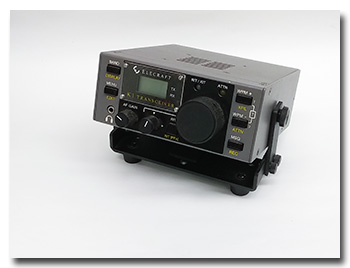by William Eric McFadden
From the manual (rev J, March 24, 2015):
-
The K1 is a versatile, low-power CW transceiver that covers two or four builder-selected HF bands. It provides 5 watts or more of power output; excellent receiver sensitivity and selectivity; and many useful operating features, including instant band selection, receive and transmit incremental tuning (RIT/XIT), digital display, configuration menu, and multiple crystal filter bandwidths.
With receive-mode current drain of about 55 mA, built-in keyer, and a stable, low-frequency VFO, the K1 is ideal for portable operation. It's also one of the smallest multi-band HF transceivers available—smaller than many single-band rigs. And, when used with the optional wide-range tilt stand (KTS1), the K1 is truly trailfriendly. The tilt stand comes with long arms for ground-mounting, as well as shorter arms for desk-top use.
Like our all-band K2 transceiver, the K1 uses modular construction, allowing it to adapt to your operating needs. The Filter board covers either two (KFL1-2) or four (KFL1-4) bands, and a different Filter board can be swapped in at any time. There are two plug-in options, including a noise blanker (KNB1) and automatic antenna tuner (KAT1). There's also an internal AA-cell battery option (KBT1). These options can be installed easily at any time.
The K1's modular assembly will also appeal to first-time builders. The kit requires almost no point-to-point wiring, unlike earlier designs that used wiring harnesses. The K1 even provides its own built-in test equipment, including battery voltage monitor, wattmeter, and frequency counter. The manual provides complete troubleshooting and signal tracing procedures, and you'll find further support on our website, www.elecraft.com.
My K1, serial number 460, has a "rev D" RF-board, firmware revision 1.09E. and the following options:
- KFL1-4 Four-Band Filter Board (15/20/30/40m)
- KNB1 Noise Blanker
- KAT1 Automatic Antenna Tuner
- KTS1 Wide-Range Tilt Stand (without the long legs)
Since my K1 was already built when I purchased it, I can't comment on the building of a K1.
My K1 also came to me with what I expect is the original KFL1-2 Two Band Filter Board which had been built for 20m and 40m. I sold this in Fall of 2021 to a ham that needed a 20m/40m filter board for his K1.
Update 2020-08-27: After I discovered low transmitter output on some of the bands, and after contacting Elecraft tech support for the KFL1-4 Manual, I performed a 4 Band Receiver Alignment and a 4 Band Transmitter Alignment following the instructions in the KFL1-4 Manual. Once I discovered on page 14 of the KFL1-4 Manual that a jumper was required on J2 of the KFL1-4 when the KAT1 isn't installed—as it can't be when one is performing the alignment procedures—the procedures went smoothly and my K1 now shows proper transmitter output on all four bands.
Update 2022-03-16: I thought to measure the K1's output power again, to verify that vibration from many trips in the automobile hadn't led to misalignment, and was distressed to see that power output was greatly reduced on 20m and 40m. Convinced I would need to again perform the alignment steps, I put the transceiver away until I had to the time to properly tackle the realignment. A few minutes later, I suddenly wondered if the KAT-1 internal ATU had been engaged, hooked up the rig again, and found that the KAT-1 had, indeed, been enabled. Setting the KAT-1 to "CALS" mode allowed the K1 to again produce full output as measured on an external wattmeter into a dummy load. Important Tip: Always check to make sure the KAT-1 is disabled before panicking about lower-than-normal power output!
Manuals:
- Manuals for the K1 transceiver and options (except the KFL1-4) are available at Elecraft (link).
- KFL1-4 Manual & Errata
Elecraft K1 Advertisements & Brochures:
- K1 Data Sheet 0706 Rev. B
as downloaded from Elecraft (654kb PDF)
Elecraft K1 Links:
- Elecraft
- (more links coming soon)
Attributions: Advertisements scanned from original documents.
